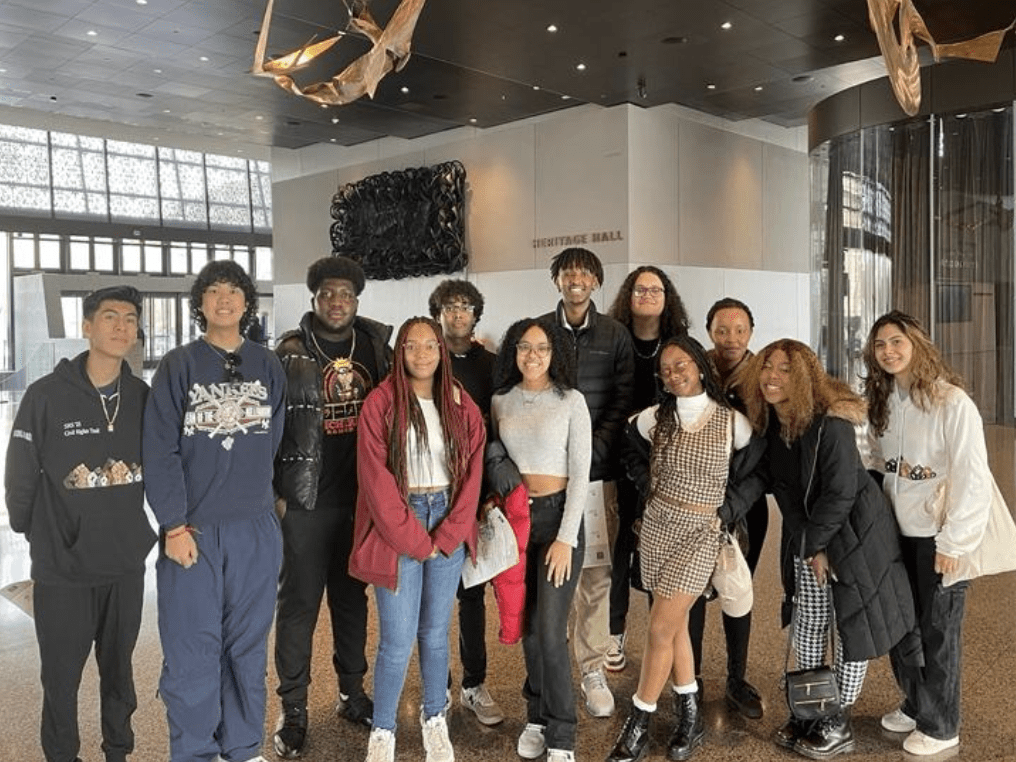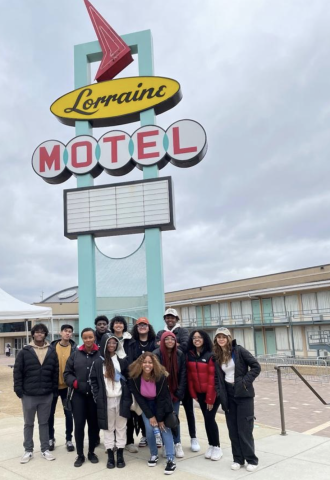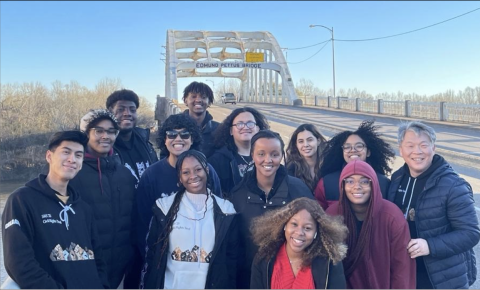I imagined taking students on this trip ever since I arrived on Colgate campus in 2002. When the National Museum of African American History and Culture finally opened to the public in 2016 and the Legacy Museum: From Enslavement to Mass Incarceration opened in 2021, I saw the SRS experience as an ideal way to engage students on the topics of white supremacy, cultural and institutional racism, and the fight for freedom.
The SRS Civil Rights Trail takes a path through cities, sites, and museums dedicated to telling the story of Black history from multiple perspectives, including first-hand accounts of joining in the marches. Ultimately, students engage with the past and how it impacts their present and future.
We started in Washington, D.C., with a visit to the National Museum of African American History and Culture. A certain theme begins here with an account of enslaved people, the human desire for freedom, and the trauma that continues to impact Black lives today. The lower floors focus on the slave trade, colorism, racism, and greed, while the upper floors celebrate contributions, accomplishments, communities, arts and music, performing arts, and sports in Black history.
From D.C., we traveled to Memphis, Tenn., to visit the National Civil Rights Museum at the Lorraine Motel. We are met again with the fight for freedom, the rights of human existence, and the inhumane treatment of Black and brown people in America. The significance of this museum is that, at the end of the tour, visitors enter the hotel room where Martin Luther King Jr. was staying and look out on the balcony where he was assassinated. The chill, the witness of hate, the want for revenge, the desire for “justice,” and the question of non-violence protests met with violence all come to a crux at this point in the tour. We then cross the road to the Legacy Building, which houses the timeline of Martin Luther King Jr.’s assassination.
After a night on Beal Street, listening to live blues and rock and roll, we take a long drive during daylight through the sundown parts of the United States to Montgomery, Ala. This is the core of our journey. Visiting the Legacy Museum provides us with the direct connection to today’s mass incarceration, with the white supremacy and cultural racism of the past and present. Students talked about the power of the museum, the way in which the museum forced them, compelled them, wrapped them in a relationship with the past, the stories, the people, and for me, the children.
As we build relationships with the enslaved people of the past, we grasp the realities that the “benevolent” slave owner does not exist and the populations that prioritized their own personal gain (wealth) were just as responsible as the slave owners, brokers, and merchants. We are then forced to ask ourselves, “Are we part of the community that just stands by and witnesses the mass incarceration, the white supremacy that occupies our judicial system, and in some ways financially benefits from this racist institution?”
After exiting this museum, we shuttled over to the National Memorial for Peace and Justice, also known as the Lynching Memorial. The terrorism of the past is on full display in this outdoor memorial. We walk along a path of hanging steel columns that hold the names of Black children, women, and men lynched in each county (not state, but each county). At the beginning of this memorial walk, the names are at eye level, but as we continue on our journey, the steel columns are all hanging from above us, putting us in the position, again, of bystander to these lynchings, forcing us to ask, “What would I do as a witness to this terror, and what will I do to engage in anti-racism, anti-mass incarceration?”
The nonprofit Equal Justice Initiative, founded by Executive Director Bryan Stevenson (author of Just Mercy), legally represent humans who have been convicted and incarcerated and runs these two exhibits. I strongly urge people to visit, to read, and to watch the work surrounding these two museums.
The students told me that we needed more time for reflection following these museums. They were traumatic, and students needed time to debrief, to understand and share the feelings that these museums forced them into. I promised them that, when I take the next group of students in January 2024, I will schedule in time after each visit for time to debrief, to breathe, and share.
We were then back in our fully packed van to drive to Selma, Ala. We were driving along the path of the 1965 march, from Selma to Montgomery, that eventually forced President Lyndon B. Johnson to sign the Voting Rights Act of 1965. When we enter Selma, we see the poverty of the city; all of downtown is closed on a Saturday afternoon, and, behind us, we see the famous Edmund Pettus Bridge. We are met by our tour guide who gives us a personal account of joining the 1965 march and violence that ensued at the foot of the bridge to stop the march. Alabama State Troopers and armed citizens (sounds similar to Kenosha, Wisc., 2020) violently attacked the peaceful marchers and turned them back on that day.
Our experiences to this point left us mentally exhausted and physically tired, but at the same time Atlanta was waiting for us. The students were housed in an AirBnB near several HBCUs. We arrived late on Saturday and the students had all of Sunday for themselves to explore the city. On Monday, the celebration of Martin Luther King Jr. Day filled the city. President Joe Biden spoke at the famous Ebenezer Baptist Church. We walked the grounds and paid respects at the tomb of Martin Luther King Jr. and Coretta Scott King. In the evening, we spent time debriefing, sharing, and connecting. It was hard to imagine all that we experienced over the past eight days and the desire to bring that experience back to our peers, family, and Colgate community.
I pray that this experience remains with all those who were able to experience it with me.


